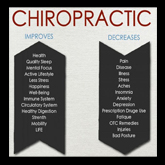
What is a chiropractic adjustment?
A chiropractic adjustment involves the manipulation of the spine and joints to realign the skeletal system. Although a spinal realignment or neck adjustment are the primary chiropractic manipulations patients think of when they consider chiropractic care, chiropractors also treat the joints.
Chiropractors are specifically trained to manipulate the spine with either their hands or small instruments. Each doctor implements different chiropractic techniques to effectively release tension on the joints and restore movement.
Do you have a baby or any children? Chiropractic care for young ones is safe and very important. Read about newborn chiropractic adjustments and get them started early on a path to better health.
Chiropractic adjustment benefits
Chiropractic benefits the patient’s physical flexibility as well as their overall functioning capability.
Maintaining a healthy spine is imperative to one’s overall health. What many people do not realize is that the nervous system relies heavily on a properly aligned spine. This is because there are numerous pairs of spinal nerves that run through the openings within the vertebrae to the brain.
These nerves and the messages they receive directly impact the muscles and tissues surrounding them. When the vertebrae are compressed or otherwise compromised, the nerves receive mixed communication from the brain.
This communication glitch then causes problems within the nervous system which regulates all of the body’s systems. As you can see then, spinal realignment is imperative to the health of the entire body with its direct impact on the circulatory, digestive, elimination, immune, muscular and respiratory systems.

Common health issues treated
Following is a list of common health issues and results people seek chiropractic care for:
- bulging disc treatment
- carpal tunnel syndrome
- degenerative disc disease treatment
- disc herniation
- headaches and migraines
- lower back pain
- lower back pain in early pregnancy (and throughout pregnancy)
- lumbar decompression
- pinched nerve treatment
- sciatica treatments
- severe neck pain
- spinal decompression
- tennis elbow
- TMJ (Temporamandibular Joint Syndrome)
If possible, try to schedule a massage (unless within the first trimester of pregnancy), even if for only thirty minutes, immediately before your chiropractic adjustment. The chiropractic manipulation will be easier on your body if the muscles have been warmed up and relaxed. This approach allows for more freedom of movement in the spine.
What to expect on your first visit
If this is your first visit, you will be required to fill out a form about your medical history and the reason for your visit. Insurance information will be collected as this alternative therapy is often covered by insurance, although this depends on your insurance.
After this process is complete, the chiropractor will take a set of x-rays of your spine and if necessary, other areas if indicated by the purpose of your visit, such as a fall or accident. They will most likely ask a series of questions and conduct painless tests to evaluate muscle response.
The chiropractor may or may not provide a spinal or neck adjustment on your first visit. This will depend on the doctor, their policy and what they believe might be going on with your system. It is in your best interest to be patient and allow them to review the x-rays before providing the chiropractic alignment. In this case, you will schedule an appointment to return for your first spinal adjustment.
What to expect from an adjustment
Now that you are ready for your adjustment, the following is the basic of what you can expect.
You will not disrobe for your appointment unless you are receiving a massage prior to your chiropractic adjustment.
If that is the case, you would be given your privacy to get ready for the massage and cover up on the massage table. It is possible the therapist may apply an analgesic cream or other topical pain reliever to help the muscles relax.
Please refrain from scheduling a massage if you are within the first trimester of pregnancy or have other possible contraindications.
After the massage, you will get dressed and return to the chiropractor to continue the treatment.
Either after your massage or in lieu of a massage, most chiropractors will place electronic stimulation via the tens unit, on the areas of your body that are the most tense. Generally, but not always, this will be the upper back, between the shoulder blades, to relax the muscles prior to your adjustment.
There are several specialty tables available for chiropractic use. Some examples are a rolling table, water table or other type of table for you to lay on that provides a massage to your back. In addition, there is a traction device that is excellent for providing spinal decompression as well as an inversion table to decompress the spine by hanging upside down for a couple of minutes (you will not be left unattended).
After enjoying any or all of the specialty tables available, the chiropractor will then have you lay on the table, face up or face down, and begin the adjustment. They will start by putting your heels together to check your alignment. Then, they will begin the adjustment itself.
If lying face down, expect them to push on your back, following your spine all the way down. After the basic back adjustment, they’ll have you turn onto your side and apply a twisting motion. You will then turn to the other side and they’ll repeat the process. Finally, you will rest on your back where they will provide a neck adjustment. The hips might be adjusted as well.
Of course, every adjustment will vary. Not just per person, but also per visit. As your circumstances change, the chiropractor will adjust accordingly. Always disclose when there has been a change in your health or if a new concern has presented itself.
After your visit and how often to have an adjustment
After a chiropractic adjustment, you might be tender in certain areas that were particularly tight when adjusted. This will pass shortly. Drink plenty of water to hydrate your muscles.
Many chiropractors now offer nutritional supplements in addition to their practice. Often, they are able to provide excellent suggestions to assist with various health concerns you might have. Be sure to inquire and consider adding them to your regimen.
Your chiropractor will suggest how frequent your visits should be when you begin a treatment. It is common to start with 2-3 per week for the first month, backing off gradually until you reach a maintenance program of once or twice a month.
Treatment programs vary depending on your health and the overall purpose of your visits.
Categories for Chiropractic Adjustment
Alternative Therapies
Bodywork Treatments
As an affiliate, we earn a small commission for qualifying purchases via links on this site. The commission is paid by the advertiser and does not affect the price of the product or cost the consumer. It is how we help pay to keep this site free to use!
